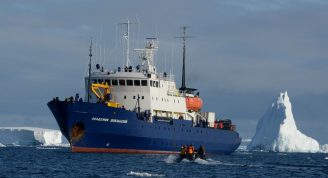Description
Perhaps no other sea in the world has witnessed as much human suffering and misery as the Sea of Okhotsk. Between 1932 and 1953 it is estimated that over 3 million prisoners (the vast majority of them innocent) were transported across the Sea of Okhotsk to the Gulags of the Kolyma Goldfields. It is estimated that only 500,000 of those prisoners survived to make the journey home. The town and port of Magadan were built to process these prisoners.
The upper regions of the Sea of Okhotsk remain frozen for much of the year and winter storms make it an inhospitable place. However the lure of a rich fishery and more recently oil and gas discoveries means this sea is still being exploited, so nothing has changed there. In 1854 no fewer than 160 American and British whaling ships were there, hunting whales. Despite this seemingly relentless exploitation the wildlife thrives, including the beautifully marked and rare Ribbon Seals. On three small islands within this sea hundreds of Steller Sea Lions haul out each year to breed. One of these, Tyuleniy Island, also is home to one of the largest concentrations and breeding colonies of Northern Fur Seals in the Russian Far East.
Seabird numbers in the Sea of Okhotsk can only be described as spectacular. There are islands like Talan where the sky darkens when the Crested Auklets start massing offshore of an evening. Other birds include guillemots, puffins, auklets and fulmars. But the richness of birdlife is not restricted to pelagic species. The Sea of Okhotsk has one of the highest concentrations of the majestic Steller’s Sea Eagle of anywhere in the Russian Far East. Waterfowl are common as are many migratory species. Harder to see but not uncommon on this expedition are the magnificent Kamchatka Brown Bear and other mammals such as the Arctic Ground Squirrel.
















